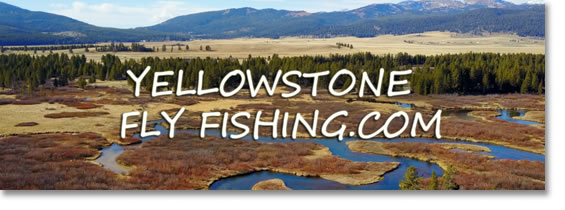 |
|
|
Gardner River Rising on the northeast slope of Joseph Peak in the northwest corner of Yellowstone Park, the Gardner is first seen by most anglers in Gardner's Hole. Hole, as a place-name in the West, is a term of varied significance. It is applied to high landlocked basins (Freezeout Hole), to mountain-girt valleys (Jackson's Hole), to desert sinks (Humboldt's Hole) or even to a spot on a river where the water depth increases sharply. Most generally, in the northern Rockies, it refers to a subalpine basin, and that is what Gardner's Hole is. It is surpassing beautiful. The river starts as a tiny, icy trickle almost 10,000 feet up. By the time it reaches the northwest corner of Gardner's Hole it has been joined by several other icy small streams but it is not yet fish worthy. In Gardner's Hole, which it traverses the full length in a northwest-southeast direction, it is joined by Fawn, Panther, Indian and Obsidian creeks, as lovely a quartet of trout stream names as one will find, and the streams are just as lovely. All are small, winding, willow lined, clear and cold, and all host numbers of brook and rainbow trout. These four streams, and the river here, are the only ones in the Park that may be fished with worms-but only by children twelve years and under. This is a family fishing area, with an excellent campground located near where Panther, Indian and Obsidian creeks join the main river. The Park administration, in choosing this as a family fishing area, acted with a wisdom not always applied to other aspects under their control. The area abounds with deer, elk, moose, waterfowl, beaver, squirrels, chipmunks and other small creatures, and birds. Opportunities for wildlife photos are everywhere. The area is scenic and the main road just a few hundred yards away. The fish are mostly panfish size. A rainbow or brookie of a foot or more is a bragging fish. The small, winding streams with their undercut banks and clearly defined deeper spots, are ideal for worm fishing by the beginning angler. The mainstream at the confluence with the other creeks is also largely a panfish proposition. But it is a delight to fish with small wet flies, a high-riding dry fly and, in season (August and September), with a hopper pattern. From where it passes under the Norris-Mammoth road bridge, there is downstream a mile or so of very pleasant water. But as one proceeds, the walls of the canyon move steadily inward upon the stream, the bed becomes rocky and boulder filled aqd one is at last forced to proceed almost entirely in the stream if he wishes to continue. In a while, with Bunsen Peak towering over the stream to the north and the abrupt face of Sheepeater Cliffs on the south, the stream becomes a torrent racing for its leap over Osprey Falls, and the even steeper canyon below. It is dangerous to continue. It returns to a more fishable approach under the soaring bridge on the Mammoth-Tower Junction road. Here one may fish his happy way both up and down stream. It is swift, boulder-filled pocket water, and the fish, somewhat larger than above, arte also more plentiful. Lava Creek adds its mineral-rich input just downstream of the road bridge and almost doubles the flow. The next approach to the river is a dirt road from the newer housing section for Park Headquarters at Mammoth. By using both approaches one can cover the entire area between without walking or wading more than a half-mile. From the housing area road it is another half-mile before the stream comes into sight along the Mammoth-Gardiner road (roads in Yellowstone Park are not numbered but are identified by the names of the areas at either end of a section of road). The five miles or so of stream in the Mammoth-Gardiner area are very pleasant miles to fish. There is just enough difficulty getting into and out of the stream, and in fishing it, to deter the casual, and the regulations and constant patrol by rangers give pause to the meat fisherman. It is a prolific piece of water for the proficient fly-fisher. The fish are larger than farther up, and there are, now and then, run-up fish from the Yellowstone, which the Gardner joins within the boundary of the town. A knowledgeable fly-fisher can, on a good day, take and release fifty or more trout. But he can also get skunked. You must know what you are about to do well in the lower Gardner. The "salmonfly," really the giant stone fly Pteronarcys califomica, emerges (hatches, in angler parlance) in June and July. Thus the nymphs of this insect are always in the stream, since it lives there four years from the time the egg is laid until it becomes a flying adult. A large black fly such as a Woolly Worm or one of the nearly two dozen local nymphal imitations will take fish most of the time. These are difficult to fish in this broken, boulder-filled pocket water stream and only the experienced nympher will do well. |